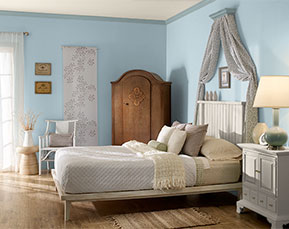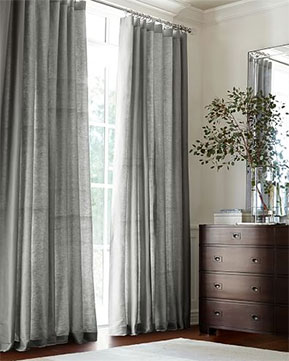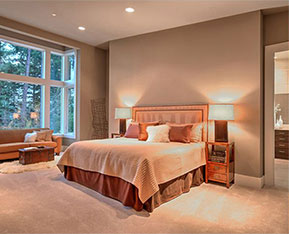Designing Bedrooms Conducive to Sleep
by Rachel Lyon, Editorial Director for Direct from the Designers™
We all know how important and restful a night’s sleep is, but that doesn’t make it any easier to achieve. Between stressful days and feeling the need to be constantly connected through various screens and media, what once used to be the simplest part of life now seems like a chore to many people. It might appear like we treat it as such in today’s busy world, but quality sleep isn’t a luxury—it’s vital for health and productivity. If you consistently fail to rest well, it could lead to problems in the future, too.
Lifestyle is a major area to address if you aren’t sleeping properly, but have you stopped to consider what your bedroom is doing for you? Maybe it’s time to cut distractions like the television with its bright light that disrupts your circadian rhythm and the cluttered desk or shelves that make you feel anxious, but what next? Here are some ideas to help you design a bedroom that’ll improve both your days and nights!
Choose Comfortable Colors
Kids love the thought of personalizing their rooms with bright shades of their favorite colors, but that only makes it easier to stay alert when it’s time for bed. Adults can be guilty of this, too, by not carefully considering the effect that certain hues have on them. So, what’s the perfect color for bedroom walls? It depends on the individual, but everybody can agree that soft tones are the way to go.
The color you choose should complement the bedroom and how you see it. Do you feel more comfortable in a spacious setting? Opt for lighter walls. Does a closer atmosphere provide the kind of coziness that’ll help lull you to sleep? Select something darker. If it’s difficult for you to unwind, cool colors can help you relax, but if you respond better to feeling embraced and secure, you might find that warm colors are the answer. With all the variation in human personality, it should come as no surprise that some people sleep more soundly surrounded by sky blue while others are better off with a deep, rusty orange.
Choose a basic palette to stick to as you decide on your bedroom scheme. You can balance the main color with complementary touches on trim, furniture, and bedding; doing so will create a more natural and inviting space that you will want to retire to at the end of the day. In this way, you can avoid overwhelming yourself with your comfortable hue and just let it work in the background to help you drift to sleep.
Control Light
Anybody who goes camping knows just how much power the sun has over waking and sleeping. In the absence of electricity, we would all have a better appreciation of how our bodies respond to this cue from nature, but all you really need to know is that dark is a signal to rest and light says to get up.
So, bedrooms should tend toward darkness. If there are sources of light brightening the room at night, get rid of them. Sleep experts will tell you to ditch the television from the bedroom entirely and avoid using digital devices at night, because their glow confuses your brain into thinking it’s time to be awake. Even something small like a digital alarm clock might be casting enough light to prevent restful sleep, so be decisive as you remove anything that illuminates where you’re supposed to rest.
Of course, you should still have artificial lights in the bedroom for safety and when you aren’t quite ready for bed. The trick is to lower their intensity so they can’t jar your mind. A dimmer switch is great if you want to be able to control light levels for different situations, but if your bedroom is only for rest and relaxation, you can simply choose low wattage bulbs and use lamp shades that help diffuse the glow for a gentler ambiance.
How to handle natural light is another matter that depends on your latitude, schedule, and preferences. The sun is a great wakeup call if you want or need to be up around the time it rises, but most of us don’t stick to its timetable. Invest in heavy or blackout curtains if the slightest sliver of morning sun wakes you. And when you are already up, be sure to get some of that light—it’ll help your body know what time it is to help you feel alert until it wanes and it’s time for bed again.
Consider Furniture Arrangement
Creating a good place to sleep isn’t as simple as putting a mattress in a room. Think about the placement of the bed in relation to other furniture and any doors and windows. If your attention is drawn anywhere but dreamland when you’re in bed, you probably need to rearrange.
The bed shouldn’t directly face any windows or doors. Direct sun and any light that comes in when a door is opened at night will disturb sleep, but even if you take measures to prevent unwanted illumination, these points are still inherently distracting because they go beyond the bedroom. Stuffing the bed into a dark corner isn’t the answer, though. Ideally, it should be positioned so you don’t automatically focus on anything in particular, so find a place from which everything looks a bit offset. For example, putting the headboard against the same wall as the door will keep you from trying to look out, and if you can do that and have windows off to the side, you’re all set.
Also be aware of your other furniture so it avoids creating too much of a focal point and it keeps the room safe for navigating in the dark. When your belongings are neatly contained, not only will your mind be at ease, but you'll find it will be much easier to walk through the room when the lights are out.
Whether you’re designing a relaxing master suite or you need to overhaul the bedrooms of every member of the family, following these few tips will help you address the largest obstacles to sleep and help put them to rest.
BROWSE HOME PRODUCT ARTICLES
- Creating a Spa-Like Master Bathroom »
- Designing a Water-Efficient Bathroom »
- Design a Modern Bathroom »
- View All Bathroom Articles »
- Building a New Home »
- Building a Duplex »
- Finding the Right Home Builder »
- View All Building Tips Articles »
- Adding the Right Columns»
- Decorative Touches for Your Interior»
- Shutters for Every Architectural Style »
- View All Columns & Millwork Articles »
- How to Use Specialty Laminates »
- Decorative Touches for Your Home's Interior
- View All Countertops and Surfaces Articles »
- What Goes Into a Great Deck? »
- Decorative Touches for Your Home's Interior »
- View All Decking Articles »
- Choosing Glass for Your Entry »
- Stylish Personas for Your Front Door »
- Using Sidelites and Transoms »
- View All Door Articles »
- Choose Siding for Your Region »
- Get the Most Out of Exterior Paint »
- Mixing Siding to Define Your Exterior »
- View All Exterior Articles »
- Finding the Right Home Builder »
- The Appeal of Small House Plans »
- Choosing the Perfect Floor Plan »
- View All Finding a Home Plan Articles »
- Colorful Flooring for Your Home »
- Designing With Different Widths»
- Chic, Neutral, Gray Flooring »
- View All Flooring Articles »
- Garage Doors That Add Curb Appeal »
- Caring for Your Garage Doors »
- Benefits of Insulated Garage Doors »
- View All Garage Door Articles »
- Reclaimed Products for Your Home »
- Building a Green and Stylish Home »
- Benefits of Building with SIPS »
- View All Green Building Articles »
- Cool Gadgets for Your New Home »
- Creating a Hi-Tech Home »
- Efficient Gifts for New Homeowners »
- View All Home Electronics Articles »
- Improve Your Home's Air Circulation »
- How to Improve the Air Circulation in Your Home »
- View All HVAC Articles »
- Bedrooms Designed for Sleep »
- Selecting a Fireplace for Your Home »
- Crafting a Luxurious Master Suite »
- View All Interior Design Articles »
- Design the Perfect Outdoor Space »
- Dive into a Beautiful Pool »
- Design a Sizzling Outdoor Kitchen »
- View All Outdoor Living Articles »
- Apps to Help You Pick Paint Colors »
- Create the Perfect Mood with Paint »
- How to Read the Color Wheel »
- View All Painting & Decorating Articles»
- Creating a Spa-Like Master Bathroom »
- High-Impact Kitchen Upgrades »
- Creating a Water Efficient Bathroom »
- View All Plumbing Fixtures Articles»
- Cladding That Complements Your Exterior »
- Reasons to Consider Prefinished Siding »
- View All Siding & Cladding Articles»
- All About Solar Powered Skylights »
- Natural Lighting for the Dark Corners of Your Home »
- Design a Better Bedroom with Skylights »
- View All Skylight Articles»



